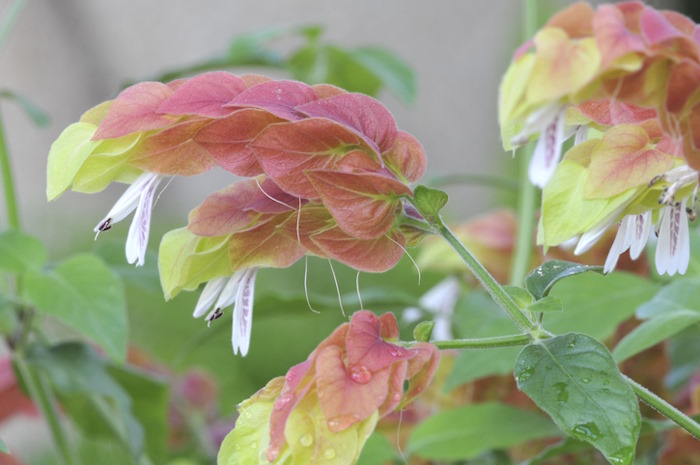Shrimp Plant
Botanical Name: Justicia brandegeana (aka Beloperone guttata)
Shrimp plant gets its common name from the arching 3- to 4-inch spikes of overlapping bracts that cover this plant nearly year-round.
Get care tips for growing this flowering house plant. Find out how to get the best color, when to prune, repot, and water this eye-catching plant.

Get to Know Your Shrimp Plant
The showy bracts range from reddish-brown to coppery pink to golden yellow. You'll get the best color by providing plenty of light. Keep the plant in a bright location where it will get some direct sun.
Small, white flowers that appear at the end of the bracts are insignificant and last only a short time.
Pinch your plant. Pinch off the growing tips often to encourage branching. You'll be rewarded with a much nicer-looking plant that is compact and bushy. If you want, you can propagate the stem tip cuttings for more plants.
This shrubby perennial will last for several years. Its upright, woody stems are covered with velvety, evergreen foliage. The pointed, oval leaves are about 1-3 in (2.5-8 cm) long. It'll get tall and leggy if not pruned back regularly. If you don't prune it, you may need to stake its weak branches.
Regular pruning is needed to control its growth and to prevent it from becoming leggy. Prune it back hard in early spring -- by half when necessary.
Repot in spring when it has outgrown its pot. You can repot and prune at the same time, you won't hurt this plant at all.
Justicia Brandegeana Varieties
You may find this plant classified as either Justicia brandegeana or Beloperone guttata. Cultivars are available with yellow, salmon or brick-red bracts. J. brandegeana 'Yellow Queen' has yellow bracts. 'Fruit Cocktail' has yellow and green bracts with pink flowers.
You may be able to find Shrimp Plant at garden centers, if you live in a region that is warm year-round. Or look for it at online nurseries.
Shrimp Plant Problems, Solutions and Answers
Dropped leaves? Root-bound plants sometimes drop their leaves; repot every year to prevent leaf drop. You'll have a much healthier plant by giving it fresh potting mix.
Yellow leaves are a symptom of overwatering. Water thoroughly, then allow soil to dry before watering again. Shrimp Plant is more tolerant of dry soil than wet.
Something bugging your plant? Whiteflies, scale insects and aphids are attracted to houseplants, especially during the spring and summer. It's a good idea to look over your plant regularly for any signs (nibbled, discolored or sticky leaves) of an invasion, and treat any infestation immediately.
Shrimp Plant Care
Origin: Mexico
Height: Up to 3 ft (90 cm) if not pruned back.
Light: Shrimp Plant needs plenty of light to bloom. Give it bright light with as much direct sun as possible. If you don't have a sunny window for it, moving your plant outdoors for the warm months will give it the sunlight it needs to grow.
Water: Water thoroughly, allowing the soil to dry out almost completely before watering again. Yellow leaves are caused by overwatering. Always use a pot with a drainage hole to prevent soggy soil. Water less in winter when growth is slow.
Humidity: Average room (around 40% relative humidity). If air is dry, using a cool-mist room humidifier is the most efficient way to increase moisture.
Temperature: Average room temperatures 65-75°F/18-24°C. You can move it out to the patio for the summer, if you want. Bring it back in if the temperature drops; it will tolerate a minimum of 60°F/16°C.
Soil: All-purpose houseplant potting mix
Fertilizer: Feed every 2 weeks spring through fall with an all-purpose water-soluble fertilizer diluted by half.
Propagation: Take 4 in (10 cm) stem tip cuttings in spring. Remove the flower bracts from the stem and insert in moist potting medium.


